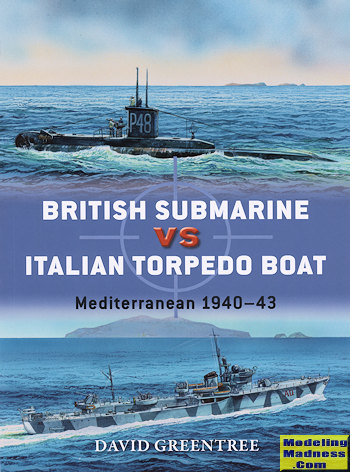 This latest
addition to Osprey's Duel series turned out to be quite an interesting read.
Little has been written about either subject and their operations in the
Mediterranean, which adds to its interest for many readers. One area where Italy
was ill-prepared for war (among many), is in anti-submarine operations. Because
of their possessions in North Africa, there was a considerable amount of
shipping between Italy and Lybia. When the war broke out, Italy was hard pressed
to find escorts. Using capital ships was not an option as Italy had rather
limited fuel reserves so relied on smaller vessels.
This latest
addition to Osprey's Duel series turned out to be quite an interesting read.
Little has been written about either subject and their operations in the
Mediterranean, which adds to its interest for many readers. One area where Italy
was ill-prepared for war (among many), is in anti-submarine operations. Because
of their possessions in North Africa, there was a considerable amount of
shipping between Italy and Lybia. When the war broke out, Italy was hard pressed
to find escorts. Using capital ships was not an option as Italy had rather
limited fuel reserves so relied on smaller vessels.
Prior to the war, there was a need for torpedo boats. These
would be capable of anti-ship and later anti-submarine duty as well as general
patrol and escort. Italy got started on all this rather late, and while the
small ships were somewhat quickly built, the truth is that there were not a lot
of them. They also lacked proper submarine detection gear and it was only in
1943 that something was installed on a few ships. Unfortunately, there were few
really talented operators. So these ships used hydrophones and aircraft patrols
to help find British submarines.
On the British side, the start of the war with Italy meant
that they needed to have boats in the Mediterranean to take care of Axis
shipping. The British were somewhat hampered in this area as some of their boats
were too big, some of them were just poor submarines that had difficulty diving
or maintaining steady periscope depth, some were not maneuverable enough, but
some were a proper size and abilities, but not available in resonable numbers.
The Mediterranean itself was an issue for the British as a
submarine's periscope was quite easily seen in the somewhat calm sea and British
submarines were easy to spot from the air in the clear, blue waters. In fact,
had the British not broken the Italian message code rather early in the war,
their success would have been even less than what it was. In the end, a lot more
British submarines were sunk by the Italians than the number of torpedo boats
lost. In fact, while contributing to the loss of Axis ships, by far the biggest
sinker of German and Italian ships was by aircraft.
Typical of this series we get a development history of both
types, information on the training of the crews as well as how the vessels were
deployed. As you can imagine, we get quite a few action reports throughout the
book showing how these vessels operated as the war progressed. I dare say that
all will find these reports to be interesting as often they are the memoirs of
those who participated in the various events. When you add in the great photos,
superb art work and various stat tables, you get a very good look at this rarely
visited aspect of WWII. In all, it is a most interesting edition
and a book that I can highly recommend to you.
June 2016
Copyright ModelingMadness.com
For more on the complete line of Osprey books,
visit http://ospreypublishing.com.
If you would like your product reviewed fairly and quickly, please contact
me or see other details in the Note to
Contributors.
 This latest
addition to Osprey's Duel series turned out to be quite an interesting read.
Little has been written about either subject and their operations in the
Mediterranean, which adds to its interest for many readers. One area where Italy
was ill-prepared for war (among many), is in anti-submarine operations. Because
of their possessions in North Africa, there was a considerable amount of
shipping between Italy and Lybia. When the war broke out, Italy was hard pressed
to find escorts. Using capital ships was not an option as Italy had rather
limited fuel reserves so relied on smaller vessels.
This latest
addition to Osprey's Duel series turned out to be quite an interesting read.
Little has been written about either subject and their operations in the
Mediterranean, which adds to its interest for many readers. One area where Italy
was ill-prepared for war (among many), is in anti-submarine operations. Because
of their possessions in North Africa, there was a considerable amount of
shipping between Italy and Lybia. When the war broke out, Italy was hard pressed
to find escorts. Using capital ships was not an option as Italy had rather
limited fuel reserves so relied on smaller vessels.